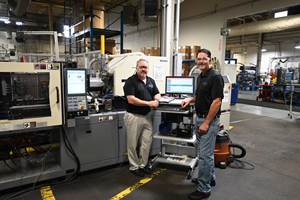Automotive Production Growth Strong
But indicators suggest market will slow in 2016.
Automotive has been strong since 2010. Interest rates have been low and incomes improving, which spurred spending on cars and parts. But the industry is likely to see its slowest growth this year since 2010. Here’s why.
Real 10-Year Treasury Rate. The “real” (inflation-adjusted) 10-yr Treasury Bond rate was 2.12% last December—the second month in a row that the real rate has been above 2%, the eighth month in a row that the year-over-year change in the real rate was more positive, and the 11th straight month that the change has increased.Typically, the year-over-year change in the real 10-yr Treasury rate leads changes in motor-vehicle and parts pending by about 12 months. So, the real 10-yr Treasury rate indicates decelerating growth in motor-vehicle and parts spending throughout 2016.
December’s nominal Treasury rate also was virtually unchanged from November. And while inflation was still historically low, the annual rate of inflation reached its highest level since December 2014. The increased rate of inflation helped temper the rise in the nominal rate, as the real rate is the nominal rate minus inflation.
Real Motor-Vehicle & Parts Consumer Spending. In November 2015, real motor-vehicle and parts spending contracted by 0.2% compared with one year ago. This was the first month-over-month contraction since February 2014. In the five months prior to November 2015, the rate of month-over-month growth was relatively weak. Therefore, the annual rate of change in motor-vehicle and parts spending has grown at a decelerating rate since May 2015.
The current annual rate of growth of 4.4% was still slightly above the historic average of 3.9%. However, over the last decade, motor-vehicle and parts spending has grown at an average rate of just 0.2%. So, compared with the last decade, consumer spending on cars was still growing at a quite a fast rate in November 2015. Spending leads production by about six months on average. Therefore, spending is indicating that production should continue its decelerating growth trend in 2016.
Motor-Vehicle & Parts New Orders. New orders for vehicles and parts grew 4% in December versus one year before. This was the 13th consecutive month of growth, although it was one of the weaker growth months during that period. The annual rate of growth in new orders was very strong in November and December. And the current annual rate of growth of 7.5% was well above the historic average of 2.7% . Orders remained quite robust in December and were a fairly positive sign for continued strength in vehicle and parts production.
Motor-Vehicle & Parts Industrial Production. Production has grown month-over-month since November 2009. However, in December 2015, the rate of growth was just 3%, which was the slowest since July 2013. The annual rate of growth has generally decelerated since April 2015. And based on the trend in interest rates and consumer spending, automotive parts production will continue to grow at a slower and slower rate in 2016.
ABOUT THE AUTHOR
Steven Kline Jr. is part of the fourth-generation ownership team of Cincinnati-based Gardner Business Media, which is the publisher of Plastics Technology. He is currently the company’s director of market intelligence. Contact: (513) 527-8800 email: skline2@gardnerweb.com
blog: gardnerweb.com/economics/blog
Related Content
Honda Now Exploring UBQ’s Biobased Material Made from Unsorted Household Waste
UBQ is aiming to expand its reach for more sustainable automotive parts as well as non-automotive applications.
Read MoreDesign Optimization Software Finds Weight-Saving Solutions Outside the Traditional Realm
Resin supplier Celanese turned to startup Rafinex and its Möbius software to optimize the design for an engine bracket, ultimately reducing weight by 25% while maintaining mechanical performance and function.
Read MorePlastic Compounding Market to Outpace Metal & Alloy Market Growth
Study shows the plastic compounding process is being used to boost electrical properties and UV resistance while custom compounding is increasingly being used to achieve high-performance in plastic-based goods.
Read MoreAtop the Plastics Pyramid
Allegheny Performance Plastics specializes in molding parts from high-temperature resins for demanding applications as part of its mission to take on jobs ‘no one else does.’
Read MoreRead Next
How Polymer Melts in Single-Screw Extruders
Understanding how polymer melts in a single-screw extruder could help you optimize your screw design to eliminate defect-causing solid polymer fragments.
Read MoreProcessor Turns to AI to Help Keep Machines Humming
At captive processor McConkey, a new generation of artificial intelligence models, highlighted by ChatGPT, is helping it wade through the shortage of skilled labor and keep its production lines churning out good parts.
Read MoreLead the Conversation, Change the Conversation
Coverage of single-use plastics can be both misleading and demoralizing. Here are 10 tips for changing the perception of the plastics industry at your company and in your community.
Read More
.JPG;width=70;height=70;mode=crop)






















